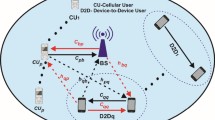Abstract
Internet of Things (IoT) is a kind of information carrier, which enables for all ordinary objects that can perform independent functions to realize interconnection. The standardization process of wireless local area networks (WLANs) which is an important network system of IoT is gradually advancing. IEEE 802.11ax will replace IEEE 802.11a/b/g/n/ac as the latest WLANs standard. The uplink transmission of IEEE 802.11ax adopts a hybrid access mode. The mode means that the stations (STAs) can access the network adopting either scheduling access mode or random access mode. Since the hybrid access mode supports both the scheduling and random access, how to allocate the resources among the STAs which adopt the two access modes is the first problem to be solved. In particular, IEEE 802.11ax focuses more on the network performance of the high-dense deployment scenarios. The characteristic of the interference of the overlapping basic service set (OBSS) situation is the key factor of the efficiency of resource allocation algorithm. Therefore, firstly, this paper combines capacity entropy multi-user access (CEM) with utility function, and defines a metric value to measure the utility of two kinds of users. Secondly, the simulation-assisted method is used to obtain the probability distribution characteristic of the interference power random variables from dense multi-cell scenarios of IEEE 802.11ax. Then, based on interference power random variables which generated by the probability density curve obtained by simulation, we propose an algorithm which can maximizetotal utility of scheduling and random access STAs, i.e., to maximize the total satisfaction of all STAs. The authors believe that the research can enhance the quality of experience (QoE) of users in dense multi-cell scenarios for the next generation WLANs.


















Similar content being viewed by others
References
Al-Fuqaha A, Guizani M, Mohammadi M, Aledhari M, Ayyash M (2015) Internet of things: A survey on enabling technologies, protocols, and applications. IEEE Commun Surv Tutor 17(4):2347–2376
Cisco (2019) Global mobile data traffic forecast update. Cisco Visual Networking Index: White Paper
IEEE. IEEE 802.11ax (D5.1) Draft Standard for Information technology Telecommunications and information exchange between systems Local and metropolitan area networks Specific requirements-Part 11: Wireless LAN Medium Access Control (MAC) and Physical Layer (PHY) Specifications, Nov 2019
Cisco (2020) IEEE 802.11ax: The sixth generation of Wi-Fi, technical white paper. Cisco white paper
Yang A, Li B, Yang M, Yan Z (2019) Concept and analysis of capacity entropy for uplink multi-user media access control for the next-generation WLANs. Mob Netw Appl 24(5):1572–1586
Yang A, Li B, Yang M, Yan Z (2019) Utility maximization of capacity entropy for multi-user access for the next generation WLANs. Comput Commun 145:309–318
Qu Q, Li B, Yang M, Yan Z, Yang A, Deng D-J, Chen K-C (2019) Survey and performance evaluation of the upcoming next generation WLANs standard - IEEE 802.11ax. Mob Netw Appl 24(5, SI):1461–1474
Yaacoub E, Dawy Z (2012) A survey on uplink resource allocation in OFDMA wireless networks. IEEE Commun Surv Tutor 14(2):322–337
Sadr S, Anpalagan A, Raahemifar K (2009) Radio resource allocation algorithms for the downlink of multiuser OFDM communication systems. IEEE Commun Surv Tutor 11(3):92–106
Song Y, Wang F, Chen X (2019) An improved genetic algorithm for numerical function optimization. Appl Intell 49:1880–1902
Mirjalili S, Dong JS, Lewis A, Sadiq AS (2020) Particle Swarm Optimization: Theory, Literature Review, and Application in Airfoil Design
Ling X, Yeung KL (2005) Joint access point placement and channel assignment for 802.11 wireless lans. IEEE Wirel Commun Netw Conf 3:1583–1588
Bianchi G (2000) Performance analysis of the IEEE 802.11 distributed coordination function. IEEE J Sel Areas Commun 18(3):535–547
Nie C, Xie J (2006) Wlc19–2: An analytical model for the ieee 802.11 dcf wlan with multiple co-channel cells. In: IEEE Globecom 2006, pages 1–5
Andrews JG, Baccelli F, Ganti RK (2011) A tractable approach to coverage and rate in cellular networks. IEEE Trans Commun 59(11):3122–3134
Xie Y, Li B, Zuo X, Yan Z, Yang M (2018) Performance analysis for 5g beamforming heterogeneous networks. Wirel Netw
Nguyen HQ, Baccelli F, Kofman D (2007) A stochastic geometry analysis of dense IEEE 802.11 networks. In: IEEE INFOCOM 2007 - 26th IEEE International Conference on Computer Communications, pages 1199–1207
ElSawy H, Hossain E, Camorlinga S (2012) Characterizing random csma wireless networks: A stochastic geometry approach. In: 2012 IEEE International Conference on Communications (ICC), pages 5000–5004
ElSawy H, Hossain E (2013) A modified hard core point process for analysis of random csma wireless networks in general fading environments. IEEE Trans Commun 61(4):1520–1534
Lei T, Wen X, Lu Z, Jing W, Chen K, Zhao X (2016) A Modified Matern Hard Core Point Process for Modeling and Analysis of Dense IEEE 802.11 Networks. In: 2016 13TH INTERNATIONAL SYMPOSIUM ON WIRELESS COMMUNICATION SYSTEMS (ISWCS), International Symposium on Wireless Communication Systems, pages 608–612, 2016. 13th International Symposium on wireless communication systems (ISWCS), Poznan, POLAND, SEP 20-23
Busson A, Chelius G (2014) Capacity and interference modeling of csma/ca networks using ssi point processes. Telecommun Syst 57(1):25–39
Liu J et al. (2014) IEEE 802.11ax Channel Model Document. IEEE 802.11ax Task Group
Kronmal RA, Peterson AV (1981) A variant of the acceptance-rejection method for computer generation of random variables. Publ Am Stat Assoc 76(374):446–451
Song G, Li Y (2005) Cross-layer optimization for OFDM wireless networks-part I: theoretical framework. IEEE Trans Wirel Commun 4(2):614–624
Acknowledgements
This work was supported in part by the National Natural Science Foundations of CHINA (Grant No. No. 61771390, 61871322, No. 61771392, No. 61271279, and No. 61501373), the National Science and Technology Major Project (Grant No. 2016ZX03001018-004), and Science and Technology on Avionics Integration Laboratory (20185553035).
Author information
Authors and Affiliations
Corresponding author
Additional information
Publisher’s note
Springer Nature remains neutral with regard to jurisdictional claims in published maps and institutional affiliations.
Rights and permissions
About this article
Cite this article
Yang, A., Li, B., Yang, M. et al. Utility Maximization of Capacity Entropy for Dense IEEE 802.11ax WLANs based on Interference Characteristics. Mobile Netw Appl 27, 141–157 (2022). https://doi.org/10.1007/s11036-020-01637-w
Published:
Issue Date:
DOI: https://doi.org/10.1007/s11036-020-01637-w




